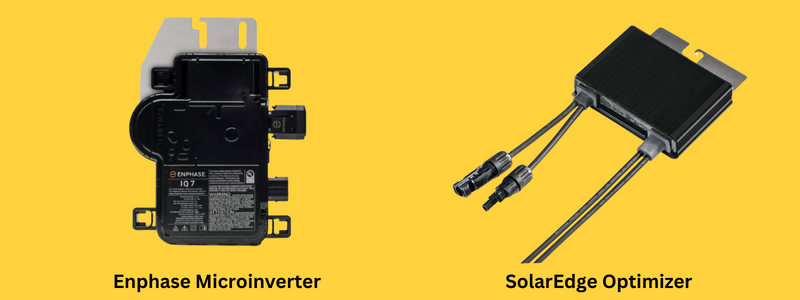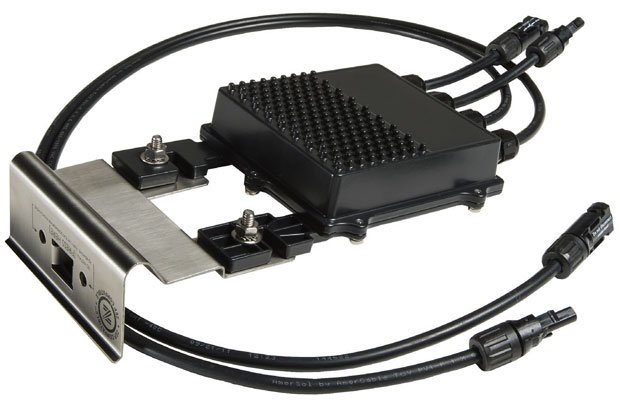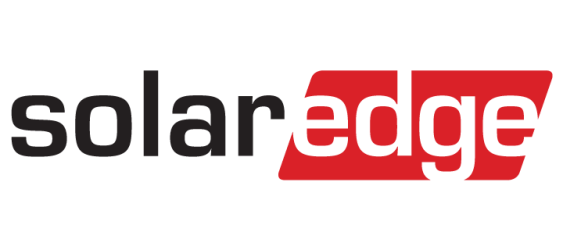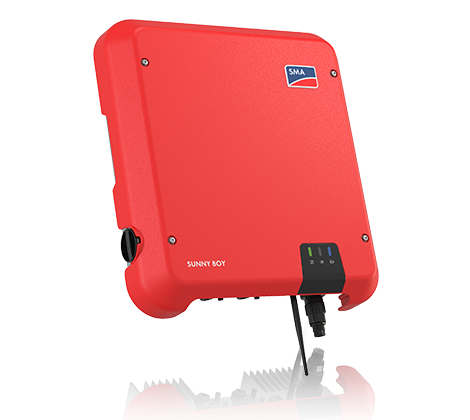Operating conditions for Photovoltaic (PV) systems can be optimized with Microinverters or Power Optimizers on a module level. These devices operate differently but optimize modules using similar tracking techniques to reach the Maximum Power Point (MPP) for each module considering the I-V Curve.

Optimizers or microinverters will increase the energy output for solar arrays (especially in partially shaded scenarios), translating into a shorter Return on Investment (ROI). This article will explain everything you need to know about Microinverters and Power Optimizers, going from:
- The basics
- Popular brands
- The lifespan of each device
- Advantages & disadvantages
- And more
Microinverter
What Is a Microinverter?

A microinverter is installed on the rear side of a PV module, replacing the function of a string inverter for the system. This device uses a Maximum Power Point Tracking (MPPT) technique to optimize the module considering the I-V curve and operating conditions. Simultaneously, microinverters convert DC power delivered from the modules into AC power at a 120V/240V AC voltage.
Since microinverters deliver AC power at the required voltage, PV modules must be installed in parallel. Microinverters allow for a modular expansion or reduction of PV systems without replacing major components. These devices also monitor the PV system, recording and reporting the performance of each module.
Popular Microinverter Brands
There are three major brands manufacturing high-quality microinverters:
· Enphase

Enphase has been at the head of microinverter technology from the start. Founded in 2006, this company has installed over 52 million microinverters in 2.7 million homes located in more than 145 different countries. Enphase microinverters are reliable and efficient, featuring top-of-the-shelf technology that delivers outstanding performance.
· AP Systems

Founded in 2010, AP Systems has become a global leading company in alternative power technology. This company manufactures some of the best and highest quality microinverters in the solar industry, featuring 1-phase or 3-phase inverters, delivering performance gains of up to 20%. AP Systems microinverters are designed to be smart, reliable, cost-effective, and extremely powerful.
· Northern Electric Power (NEP)

Founded in 2010 in the U.S., Northern Electric Power (NEP) is one of the major microinverter manufacturers. With headquarters in the U.S. and Japan, this company designs and improves high-quality microinverters for worldwide installations, delivering excellent performance for each product.
Lifespan
The lifespan of a PV system is limited by the PV modules, usually around 25 years for regular models. Microinverters also feature a 25-year lifespan, covered by a warranty of 20 to 25 years. This is a good lifespan knowing that string inverters only last 10 to 15 years.
Advantages & Disadvantages
There are many advantages to microinverters and only a few disadvantages. In this section, we address the most important ones.
Advantages
- Modular MPPT system technology improves performance for the whole PV system.
- The Microinverter lifespan matches that of the PV modules.
- Microinverters feature a longer warranty than string inverters.
- Since microinverters work modularly, the performance in partial shading is drastically improved.
- A solar array can be modified (expanded or reduced) without reconfiguring or exchanging any other component.
- Microinverters monitor each module, recording and reporting results in a web-based interface.
- No high voltage electrocution risk since there are no 300 – 600V voltage connections like with string inverters.
Disadvantages
- Higher initial cost, up to 53% more than for string inverters.
- Microinverters are not compatible with DC-coupled batteries. They only work with AC-coupled batteries.
- If one is defective, you need to get up on the roof to replace it.
While microinverters cost 53% more than string inverters, their lifespan is 1.67 up to 2.50 longer than conventional inverters. The only inconvenience is that they cannot be matched with DC-coupled batteries.
Do They Work Without the Grid?
It depends. Microinverters used in grid-tied PV systems do not work without the grid for safety reasons. For a microinverter to work without the grid, it is necessary to have an AC-coupled battery.
Do They Work With a Battery?
A microinverter does not work with conventional DC-coupled home battery systems since the output of the modules is directly converted into AC. For microinverters to work during power outages or off-grid applications, they must be matched with AC-coupled batteries that can be recharged with AC power by the inverters and provide backup power to the load when needed.
One AC-coupled battery is designed by Enphase, The IQ Enphase Battery. This battery features three IQ battery units for a total capacity of 10.08 kWh, twelve grid-forming microinverters delivering a 3.84 kW power output, and smart capabilities.
Microinverter Conclusion
The microinverter sends AC power straight to your home. The microinverters are wired in parallel. We know that parallel is better for shaded conditions. Therefore, a microinverter will be more efficient than a series string with a ground-mount string inverter.
However, in my opinion, it is not worth the extra cost. An IQ7 microinverter from enphase will cost you $200 per piece. A 25-panel installation (395wp/panel) will cost you $5000 for microinverters instead of a $2200 SMA 7kW string inverter. It is true that microinverters last longer than string inverters, but in terms of ease of installation, a string inverter is still a better choice for me.
Optimizer
What Is an Optimizer?

A Power Optimizer is a DC-to-DC converter installed at the output of each module in the PV system. This device uses an MPPT technique considering the I-V curve, to improve performance on a module level. Unlike microinverters, power optimizers do not convert DC power into AC, which is why they require a string inverter to operate in what is known an optimized string inverter configuration.
Optimizers turn each PV module in the system into smart-modules. These devices can set the voltage for the whole string, increasing the flexibility and size of the system, while also providing monitoring for each module. Some power optimizers include a SafeDC feature that brings down DC voltage to safe levels during power outages in grid-tied PV systems.
If partial shade is cast over the panel with the optimizer installed, the optimizer will increase the panel’s voltage while reducing the current. As you already know, the voltage stays the same in a series string, and the currents add up. This is why the optimizer is beneficial in a series string. Learn more about shading and series or parallel.
Popular Brands:
Two power optimizer brands stand above the rest. These are the following:
· SolarEdge

Initially founded in 2006 in Israel, SolarEdge has expanded to Germany, Italy, Japan, and the United States. This company initially focused on developing high-quality solar string inverters, but they developed high-quality power optimizers using MPPT technology at a module level, which delivered excellent results that surprisingly improved the performance of PV systems. SolarEdge optimizers are generally used in combination with SolarEdge string inverters. Up to date, this is one of the leading brands for power optimizers worldwide.
· Tigo Energy

Tigo Energy was founded in 2007, focusing on developing module-level power electronics. The power-optimizing solutions created by this company, feature high-quality designs, optimal performances, and many other benefits, delivering noticeable differences for PV systems all around the world. Tigo optimizers can be integrated into the PV system using any string inverter brand.
Lifespan
Power optimizers feature the same lifespan in theory as microinverters. These devices are designed to last for around 25 years, also matching the lifespan of the average PV system.
Advantages & Disadvantages
Similarly, there are many advantages and only a few disadvantages to power optimizers. In this section, we explain each of these.
Advantages
- MPPT system optimizes performance at the module level.
- Some power optimizers can fix string voltage, allowing for the installation of more solar panels in series using the same central inverter.
- Power optimizers turn solar panels into smart modules that can be monitored remotely and achieve rapid shutdowns required for safety purposes.
- Optimizers also mitigate partial shading impact by adjusting voltage and current levels accordingly on partially shaded modules that will not impact the rest of the system.
- Reduce mismatch power losses caused by aging and manufacturing intolerances.
- Cheaper than microinverters while fulfilling the same/similar task.
- Allows integrating different models/brands of solar panels into the same PV system without performance loss.
- It can work perfectly in systems with DC or AC-coupled batteries.
- Allow two strings with different module quantities to be connected to the same MPPT input in a string inverter.
Disadvantages
- Higher cost compared to non-optimized DC systems.
- DC voltage remains high in DC-optimized systems
A power optimizer represents a higher upfront cost for the PV system. The improved performance in partially shaded conditions can make up for that cost. In non-shaded PV systems, optimizers increase yielded energy by 2%, while optimizers in systems with partial shadings can improve performance by up to 34%.
Is There a Limit to the Amount of Optimizers?
Yes, there is a limit to the maximum number of optimizers installed per string of PV modules. According to SolarEdge, in no case scenario there should not be more than 25 power optimizers for a single phase of inverters on a string. This does not mean, however that up to 25 solar panels can be connected to any SolarEdge inverter, as this will depend as well on the inverter’s and solar panel’s power size. Similarly, the limit will depend on the inverter’s maximum DC input voltage for Tigo DC optimizers.
Conclusion
If there is no partial shading, use a regular string inverter. A string inverter will be one inverter located in your garage, for example. It’s easy to do maintenance and cheaper than optimizers or microinverters.
If you have partial shading from a tree or power line, use an optimizer on only those shaded panels. If you have a large amount of shading from a chimney, an optimizer or microinverter isn’t going to make it any better.
If you don’t have space for a string inverter, use microinverters.
Frequently Asked Questions
What Is a String Inverter?

A string inverter is a centralized type of DC to AC inverter that converts the DC power output of a PV string at a high voltage of 300 – 600V DC into AC power featuring a 120/240V AC voltage (230 – 240V for Europe). String inverters use MPPT technology to optimize performance for the string, but they do not consider operating conditions for each module, only the string, which reduces the overall performance of the system. String inverters will shut down if the grid is down.
What to Choose if You Have Shade?
In terms of performance, a combination of power optimizers plus a string inverter can be similar to a microinverter. However, optimizers are better in certain shading scenarios, considering the wider MPPT range. The optimizer and microinverter provide similar improvements in theory since they feature similar MPPT techniques, being able to optimize PV systems by up to 34% in partial shading scenarios.
Considering the cost, microinverters are a better choice because they last longer (up to 25 years!). In the combination of power optimizer plus string inverter, the power optimizers last 25 years, but the string inverter only lasts 10 to 15 years, which is why microinverters can be a better choice.
A more cost-effective method is to use optimizers for the panels that experience partial shading. As we have discussed before, the full shade of a chimney doesn’t magically increase the solar panel’s output or optimize it. Instead, the bypass diodes in the solar panel will activate.
Microinverters or optimizers are only effective with partial shading like overhead power cables or tree branches.
What to Choose if There Is No Shade?
If there is no shade, using microinverters, optimizers plus a string inverter, or simply a string inverter is practically the same in terms of performance. The microinverters will improve the system by around 2% and last longer, but the cost will be much higher than using a string inverter or an optimized string inverter. Therefore, it is more reasonable to go with a typical string inverter.
What Is the Most Cost-Effective System?
Under no-shade scenarios, using a string inverter is always the most cost-effective option.
On the other hand, under partial shading scenarios, to find out which is the most cost-effective system, we must also consider the brand selected. SolarEdge optimized system is high quality but also comes at a premium price. Compared to a microinverter system from Enphase, costs are similar when considering the optimized string inverter replacement cost (required after 15 years).
However, if the optimizers are from Tigo and the string inverter is not a premium one like SMA, for instance, then the costs can be dropped substantially. An additional advantage of a Tigo-optimized inverter system is that, unlike the SolarEdge system, not all panels need a DC optimizer, but only those with partial shading conditions. This minimizes the amount of DC optimizers that you need to install, which in case of a medium or large residential system of 10-15kW can lead to some important savings and makes it the most cost-effective solution for partial shading scenarios.
Are Optimizers Better Than Micro Inverters?
Optimizers and microinverters perform a similar function, using the same basic principle. However, optimizers work on a wider MPPT range and perform better in certain scenarios. Additionally, optimizers can work with a DC-coupled battery, which produces fewer power losses than AC-coupled batteries since these have to convert DC to AC using the microinverter, and then AC to DC to recharge the battery, losing power with each conversion.
Are Microinverters More Efficient?
While microinverters are highly efficient and deliver excellent performance, optimizers work on a wider MPPT range, delivering better and more efficient results in all types of scenarios. This makes optimizers the most efficient and better choice in terms of performance.
For instance, Enphase IQ8 microinverters feature a weighted efficiency of 97%. SolarEdge on the other hand, offers an efficiency of 98.8% for its power optimizers and 99% for its string inverter, delivering a total weighted efficiency of 97.82%, slightly higher than the Enphase microinverters.
Can I Grid Tie a Solar Panel With Microinverter?
Microinverters are specially designed for grid-tied applications. You can easily grid-tie a single solar panel or a large number of them, using a micro-inverter for each module to convert DC power into AC that is injected into the grid and accounted for in your net-metering system.
If you see a balcony with a solar panel on it, you can bet it’s a microinverter.
 I have written a book that contains all the information you need to get started with off-grid solar power.
I have written a book that contains all the information you need to get started with off-grid solar power.
With over 1,800 reviews at 4.5 stars, I can almost guarantee that this book will save you $100s on buying the right equipment.
You can get it here on Amazon.com

I’m an off-grid enthusiast. I created this website to give clear and straight-to-the-point advice about solar power. I’m also the author of the book ‘Off-grid solar power simplified‘. Read more about me on my about page, check out my Youtube channel, or send me a message.
Nick, we have a 5.5kW PV array with Enphase micro inverters all connected to a Powerwall 2. in summer it all works well but in winter due to reduced insolation and increased shading the system cannot fully charge the battery most of the time.
We are off grid quite often as we are in a semi rural area with unreliable mains supply. Tesla say our current PV array is as big as the battery can safely handle from a charging perspective taking into account high solar inputs in summer especially if we happen to be off grid.
We would like to add some more PV panels to increase the solar input from May To August, We are near Perth Australia.
Have you come across this problem previously and if so what would you suggest as a solution.
Thanks for the really interesting web site.
Ian
Hello Ian, I don’t have experience with power walls. However, if you don’t have enough sun in winter, adding solar panels will be a good option apart from adding a generator. The power wall has some limitations because it is AC-coupled. In my experience I would add more solar panels to get through winter. This is the part which I don’t know if the powerwall will be damaged if the power is too high in summer (I assume not).